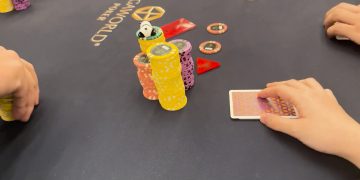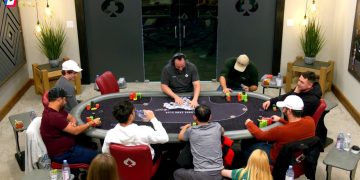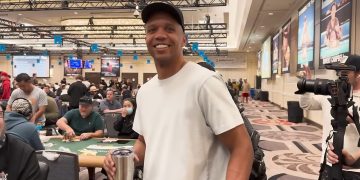Let’s get straight to the point when it comes to playing short stack poker. Most poker players don’t know what they’re doing. The funny thing about this is that you can’t blame them, which is because they’re simply listening to what they’ve been taught.
What they don’t realize is that people who teach are usually people who have failed. They would be much better off listening to someone who has been in the poker trenches and does it for a living. They have seen every situation, so they know how most situations are likely to play out.
Let’s first take a look at how the average poker player will play short stack poker. For simplicity purposes, let’s assume it’s a tournament. To add details so you have a good idea of what’s going on, let’s say it’s a $400 buy-in Monster Stack with a BB ante at the World Series of Poker Circuit (WSOP-C). All tournaments on the WSOP-C are switching to BB ante this year, so this would make sense.
Short Stack Poker: The Wrong Way to Play It

In the Monster Stack, you begin with 30,000 chips. Let’s say you’re down to 10,000 chips when the BB is 1,000. This means you have 10 BB (10 big blinds). This is seen as the danger zone by most poker players. And when average poker players think they’re in the danger zone, they panic. In other words, if they see any decent hand, they’re going all-in in an attempt to double-up. However, there are so many things wrong with this poker strategy.
The first thing that’s wrong with this short stack poker approach is that one orbit in most poker tournaments is about 15 minutes. This will depend on the speed of the dealer and players, but that’s about the average time frame. Since it’s a BB ante tournament, that means you owe absolutely nothing for the majority of those 15 minutes.
When you do owe something to the pot (aside from small blind), its 2,000 chips, which is 1,000 for the big blind and 1,000 for the ante. Now you’re down to 7,500 chips (including small blind), which many players will have a heart attack just thinking about. Obviously, it would be wise to chill out, but we’ll get to that soon.
If you’re getting all these free looks at your cards with 10 BB in a BB ante tournament, then it would make no sense whatsoever to shove (go all-in) with a hand like J9, QT, or KT. That said, like anything else in poker: It Depends. If any “poker strategist” ever tells you that you need to do this in this situation or that in that situation, they are a phony. Or, we can just refer to them as a losing player.
Short Stack Poker: The Right Way to Play It

If you’re on the button, you pick up KT and the small blind and big blind are both passive players, then you want to raise to between 3,500 and 4,000 here. Most players would just shove because KT is a relatively good poker hand, but when you shove, you only give yourself one chance at survival. When you put in a standard raise, you’re likely to take down the pot vs. these players anyway.
If you do happen to be called and lose the hand, then you’re truly short-stacked, but you’re still alive. This way, you have two chances of coming in the money. That is the right way to play short stack poker. A lot of players disagree with this approach, but those are players that are playing by the book and fit into the “masses” category. You don’t want to be in the “masses” category. You want to do whatever it takes to make money.
Now let’s say it’s the same exact situation with KT on the button and the small blind or big blind player is an aggressive player. In this situation, you want to fold. Wait for a better spot. A lot of people will think they won’t have many better spots, but most of the time, they will. You still have 10 BB in a BB ante tournament.
Once you pay the blind and ante fees, you will be down to 7,500, but you will be getting free looks at seven consecutive hands because it’s a BB ante tournament. It’s very possible you will see AJ or better in those seven hands. If not, then you evaluate the situation once again when you’re on the button. If you don’t find what you’re looking for and you lose the blind and ante fees once again, you will have 5 BB, likely less because the blinds will have increased by this time.
At this point, you want to widen your range and shove to gamble. You have no other choice. If you double-up, great. You can now go back to what you were doing before. Some people might say you had to double-up to get back to where you were, but they’re not realizing that you’re doubling the amount of chances you have to see a premium hand, which is a true double-up, triple-up, or quadruple-up opportunity. That might be played out in an all-in situation or by showdown. This is how you maximize your opportunity in short stack poker.
Short Stack Poker: The “I Have No Choice Syndrome”
The following is another enormously important reason you don’t automatically shove with 10 BB. When most people play Texas Hold’em Poker in a tournament and they see their chips dwindling, they say to themselves: “I have no choice.” But you do have a choice, and it relates to the other players, not you.
The vast majority of poker players play by the standard poker rules, but if almost everyone is playing by those rules, how do you expect to get an edge? What many players are overlooking is that fact that medium-stacks and big-stacks still end up in big hands vs. one another. Once you realize this and focus on it, you will add a lot more poker tournament cashes to your HendonMob (a site that tracks results for all regulated poker tournaments and tournament players).
This is important because when you increase your HendonMob total, you’re much more likely to attract investors. It’s also impressive when you have a bunch of final tables. That shows that you the ability to go deep in poker tournaments. So, how would someone have the ability to go deep in poker tournaments much more often than the average poker player that plays by the book? Simple: By not being the average poker player that plays by the book.
In the aforementioned situation, let’s assume you’re in a really “desperate” situation with only 5 BB and you’re in a BB ante tournament. There are 70 players remaining and 65 of those players come in the money. You’re UTG (Under the Gun, which means first to act) and you pick up KT. Do you shove?
The answer is NO! You are five places from the money with seven tables running. Most players with 15 BB or less are going to putting all their chips in the middle in an attempt to double-up so they can make a run at the final table. All the while, you can sit there and simply wait until five more players are knocked out. This is much easier than you might think. You only have to do one simple thing: FOLD!
If the BB gets back to you, still play it the same way unless you pick up a premium hand. If you can make it two orbits without an all-in (assuming you don’t pick up a premium hand), then you’re extremely likely to cash in the tournament. You might not want a min-cash, but remember that every cash goes to HendonMob, and every cash improves your brand. Also keep in mind that once you’re in the money, you can now start attacking. It’s still possible that you chip-up and get back into the game. This happens all the time.
The last thing you want is to shove with a moderate hand in this spot, get knocked out, and talk to yourself angrily about the play you made the entire way home. If you’re like most poker players, you will still be talking to yourself about it the next day while hitting yourself in the head. Let’s not do this so you won’t hit yourself in the head.
Short Stack Poker: The Concept of First-In Equity

Now figure in first-in equity, which was introduced by Dan Harington many years ago. Dan Harrington is known as a very tight player, but he will take advantage of that image and throw in a bluff at the right times—usually when deep in a tournament and he knows he can sell his image with a bluff. Most of the time, he pulls it off.
Dan doesn’t play by the book (unless it’s one of his books). He has his own style, which works for him. If you look at all the best players in the world, they all have their own style. You’re never going to find a by-the-book technical player at the top of the mountain. Those are followers and there is nothing special about them.
Getting back to first-in equity, this simply means that you need to be the first one all-in when short-stacked unless holding a monster. If you’re calling someone’s all-in, then you’re likely in a race-at-best situation. That means you might have 77 vs. KQ, which is basically a coin flip. Or, a worse-case scenario is you have 77 vs. KK. Now your odds of winning are shy of 20%. By being the first one all-in, it also puts every other player in a more defensive mode. The player that was going to raise with KJ-off is now likely to fold. He doesn’t want to risk that many chips, and he doesn’t want to double you up.
The misconception for playing short stack poker is that you must attack, but this is a misconception for the entire game of tournament poker. If you play in a big poker tournament and you see a very aggressive player, you will watch that player accumulate a lot of chips, but over the course of hours, they will lose all of those chips. They are simply playing too many hands, which means they are putting themselves in too many vulnerable spots. The pot is a dangerous place to be in Texas Hold’em Poker.
It’s like playing hide and seek in a forest when there is a forest fire. You might have fun for a while, but if you keep playing in that forest, you’re going to get burned. Even if they’re the best poker players in the world, they’re consistently going to find themselves in situations where they have top pair vs. a flush draw or the other way around, and they’re going to call. It doesn’t matter how good you are, you can’t win every flip. The real secret to tournament poker is to stay out of the way.
Think about the image staying out of the way creates. Now you’re viewed as a tight player who only plays premium hands. You spent hours building this image. Now that the blinds are higher and every hand is more important, you’re going to have an opportunity to take advantage of that image by bluffing (in the right spots vs. the right player), which will build your chip stack. That dude that was playing aggressive because he had the mindset that you must attack? He’s history.
Final Thoughts
If you want to do what “the book” tells you and play short stack poker like everyone else, shove all day. If you actually want to make money in this game, remain patient and understand that 10 BB is not really a short stack. A real short stack is 5 BB, and even then you should pick your spots. You might be ridiculed for thinking this way, but watch how much more coin you accumulate.
♠ pokerjournal.org
Short Stack Poker – FAQ
What is a short stack in poker?
A short stack is someone who has fewer chips than everyone else at the table. This can also pertain to the shortest stack in the tournament.
How do you play small stack poker?
It depends on the player. I play it very tight, very aggressive. If I get down to 10BB to 6BB, my shoving range is wider, but I won't auto-shove until down to 5BB.
What is a shove in poker?
A shove means you're going all-in. It can also be referred to as a jam.
How many big blinds is a short stack?
It depends on the stacks at your table, but 10BB is definitely viewed as a short stack by most players.

















Discussion about this post